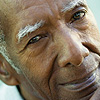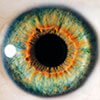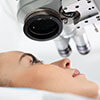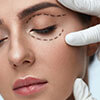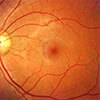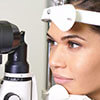Eyelid Surgery
Eyelid Surgery Resolves Various Conditions
Eyelid surgery is a common method of treatment for a number of situations, including:
- Blepharoplasty
- Chalazion
- Ectropion (outward turning of the eyelid)
- Entropion (inward turning of the eyelid)
- Ptosis (drooping of the eyelid)
- Some eyelid tumors
Eyelid surgery is usually an outpatient procedure with local anesthesia. Risks of surgery are rare, but include asymmetry of the eyelids. Differences in healing between the eyes may cause some unevenness after surgery.
After eyelid surgery, a bruise or black eye is common but goes away quickly. It may be difficult to close your eyelids completely, making the eyes feel dry. This irritation generally disappears as the surgery heals. Serious complications are rare but include vision loss, scarring and infection. To most people, the improvement in vision, comfort and appearance after eyelid surgery is very gratifying.
Blepharoplasty
Blepharoplasty Can Help Improve Appearance
As we age, the delicate skin around the eyes can appear puffy or saggy. Eyelid skin stretches, muscles weaken, and the normal deposits of protective fat around the eye bulge. The surgical procedure to remove excess eyelid tissues (skin, muscle, or fat) is called blepharoplasty.
Blepharoplasty can be performed on the upper eyelid, lower eyelid, or both. The surgery is performed for either cosmetic or functional reasons. Most often, people choose blepharoplasty to improve their appearance by making the area around their eyes firmer. Sometimes excess upper eyelid tissue obstructs the upper visual field or can weigh down the eyelid and produce tired-feeling eyes. When blepharoplasty is performed to improve vision, rather than for cosmetic reasons only, it may be covered by insurance. Blepharoplasty for the lower lid removes the large bags under the eyes. It is unusual for insurance to cover lower lid blepharoplasty.
Outpatient surgery may take a few hours
Blepharoplasty is usually performed on an outpatient basis and can take one to one and a half hours. Upper lid incisions are made in the natural crease of the lid, and lower lid incisions are made just below the lash line. A procedure for lower lid blepharoplasty, called transconjunctival blepharoplasty, removes excess fat through an incision inside the lower lid. Incisions are closed with fine sutures.
Our surgeons use a laser that seals the delicate eye tissue as it cuts, which reduces bleeding and bruising, and improves healing time. This “bloodless” laser is ideal for patients who are on blood thinning medications or on aspirin therapy.
Swelling, bruising and blurry vision are common after blepharoplasty. Stitches are removed three to five days after surgery, except in the case of transconjunctival blepharoplasty where the self-dissolving sutures usually require no removal.
Possible complications associated with blepharoplasty include bleeding, swelling, delayed healing, infection, drooping of upper or lower eyelid, asymmetry, double vision, and dry eye.
It is important to note that the puffiness of the fat pockets may not return, but normal wrinkling and aging of the eye area will continue.
Chalazion
Chalazion: Swelling from Blocked Oil Gland
A chalazion is a swelling in the eyelid caused by chronic blockage and inflammation of one of the small oil producing glands located in the upper and lower eyelids.
A chalazion is sometimes confused with a stye, which also appears as a lump in the eyelid, but is an acute infection. Chalazions tend to occur farther from the edge of the eyelid than styes and tend to “point” toward the inside of the eyelid. Sometimes a chalazion can cause the entire eyelid to swell suddenly.
When a chalazion is small and without symptoms, it may disappear on its own. If the chalazion is large, it may cause blurred vision.
Chalazion Treatments
Chalazions Respond Well to Treatments
Eyelid swelling from a chalazion can be treated in various ways:
- Warm compresses can be applied. The simplest way is to hold a clean washcloth, soaked in hot water, against the closed lid. Do this for 10 minutes, three or four times a day. Repeatedly soak the washcloth in hot water to maintain adequate heat. The majority of chalazions will disappear within a few weeks to months. Sometimes antibiotic ointments are used in combination with warm compresses.
- Apply light pressure with the finger directly over the chalazion. Do this immediately after the warm compress has been applied for 10 minutes. This pressure may help express the material inside the chalazion and reduce its size. Do not squeeze or try to pop the chalazion.
- Surgical removal may be necessary for large chalazions that do not respond to other treatment.
Chalazions usually respond well to treatment, although some people are prone to recurrences. If a chalazion recurs in the same place, your eye doctor may suggest a biopsy to rule out more serious problems.
Ectropion
Ectropion: Lower Eyelid Turning Outward
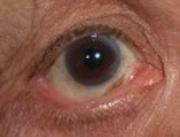 Ectropion is an outward turning of the lower eyelid, most commonly caused by aging, although eyelid burns or skin disease may also be responsible.
Ectropion is an outward turning of the lower eyelid, most commonly caused by aging, although eyelid burns or skin disease may also be responsible.
Normally, the eyelids help lubricate and cleanse the eye during blinking. An eyelid that is drooping and has lost contact with the eye can cause dry eyes, excessive tearing, redness and sensitivity to light and wind.
Surgery can be performed to tighten the eyelid and return it to its normal position. The eyelid can then protect and lubricate the eye properly, so that irritation and other symptoms subside.
Eyelid surgery to repair ectropion is usually performed as an outpatient procedure using local anesthesia.
Entropion: Eyelid Turning Inward
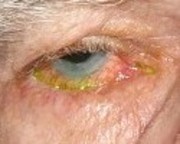 Entropion is an inward turning of the eyelid and lashes toward the eye, usually caused by relaxation of the eye muscles and tissue due to aging.
Entropion is an inward turning of the eyelid and lashes toward the eye, usually caused by relaxation of the eye muscles and tissue due to aging.
Entropion usually affects the lower lid. The skin and eyelashes rub against the eye and cause discomfort and tearing. The irritated eye can produce mucous, and become red and sensitive to light and wind. If entropion is not treated, rubbing of the skin and eyelashes can cause infection or scarring of the eye, which can cause vision loss.
Surgery can be performed to tighten the eyelid and return it to its normal position. The eyelid then protects the eye properly, and irritation and other symptoms subside.
Eyelid surgery to repair entropion is usually performed as an outpatient procedure using local anesthesia.
Ptosis – Droopy Eyelid – May be Present at Birth
Ptosis is drooping of the upper eyelid. The lid may droop only slightly or it may cover the pupil entirely. In some cases ptosis can restrict and even block normal vision.
Congenital ptosis, or ptosis that is present at birth, may require treatment for normal visual development. Uncorrected congenital ptosis can cause amblyopia, or lazy eye. If left untreated, amblyopia can lead to permanently poor vision.
Surgical Treatment for Ptosis
Except in mild cases, the treatment for ptosis is usually surgery to tighten the levator muscle that lifts the eyelid. In severe ptosis, when the levator muscle is extremely weak, the lid can be attached or suspended from under the eyebrow so the forehead muscles do the lifting.
Ptosis in adults is commonly caused by separation of the levator muscle from the eyelid as a result of aging, cataract or other eye surgery, an injury or an eye tumor. Adult ptosis may also occur as a complication of other diseases involving the levator muscle or its nerve supply, such as diabetes.
If treatment is necessary, it is usually surgical. Sometimes a small tuck in the levator muscle and eyelid can raise the lid sufficiently. More severe ptosis requires reattachment and strengthening of the levator muscle.
The risks of ptosis surgery include infection, bleeding, and reduced vision, but these complications occur very infrequently. Although improvement of the lid height is usually achieved, the eyelids may not appear perfectly symmetrical. In rare cases, full eyelid movement does not return.


